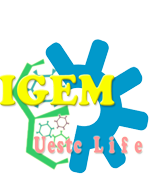Team:UESTC Life/Results and discussion
From 2013.igem.org
| Results and discussion |
|---|
Results and discussion
- Construction of plasmid with single LinA, LinB, DhaA, HheC, LinA+P2A+LinB, DhaA+T2A+HheC, LinA+RBS+LinB, DhaA+RBS+HheC.
- BBa_K1199001
- BBa_K1199002
- BBa_K1199003
- BBa_K1199004
- BBa_K1199005
- BBa_K1199006
- BBa_K1199007
- BBa_K1199008
- Isolation of a clone showing γ-HCH dehydrochlorinase activity. Growth of strain MC1061 transformed pOHC_01 and pOHC_05 with 5mM γ-HCH as the substrate was monitored in batch culture. The result was screened by GC analysis(FIG.1). Growth resulted in disappearance of the substrate and simultaneous formation of biomass andγ-PCCH et. The available column in our college is limited that the next reaction hasn’t been detected.

FIG.1. Degradation of γ-HCH in LinA and LinA+F2A+LinB clone. γ-HCH(5mM) was incubated with intact cells of each strain in LB medium at 30℃. The concentration of γ-HCH in reaction medium were measured by GC.
- Isolation of a clone showing DhaA and HheC activity. Growth of strain MC1061 transformed pOHC_03, pOHC_06 in LB medium get OD600=1.0 centrifuged and transferred the cell to a fresh medium with 10mM TCP as the substrate was monitored in batch culture. The structures of the products were confirmed using GC columns. Growth resulted in disappearance of the substrate and simultaneous formation of biomass, 2,3-DCP, epichlorohydrin, chloropropanol, and glycerin. The result was screened by GC analysis(Fig.2). Epichlorohydrin also have been detected in the culture(Fig.3). The result was screened by GC analysis(Fig.2). Above the change of TCP and 2,3-DCP indicate that multistage biodegradation are working well. As the degradation of serial halogenated compounds, the Cl^- and proton could be released in the system. High concentration Cl^- could resiste the activity of those enzyme. In low PH, the epichlorohydrin, a type of instable compound, could be decomposed immediately to product chloropropanol. As for HheC mutation we used, W249P, has extremely high activity with chloropropanol, relative to its low activity with 2,3-DCP and it also are a kind of strong enantioselectivity for the (R)-enantiomer. So, the epichlorohydrin and chloropropanol concentration are too low to be detected and there were a little residual 2,3-DCP. According to the total TCP and 2,3-DCP, we can find it has decreased. As a result, multistep reaction, bio-degrading TCP, can work.

FIG.2. Degradation of TCP in DhaA+P2A+HheC clone. TCP(5mM) was incubated with intact cells in LB medium at 30℃. The concentration of TCP and is metabolites in reaction medium were measured by GC.

FIG.3. Degradation of TCP in DhaA clone. TCP(5mM) was incubated with intact cells in LB medium at 30℃. The concentration of TCP and is metabolites in reaction medium were measured by GC.

FIG.4. Degradation of TCP in HheC clone. 2,3-DCP(5mM) was incubated with intact cells in LB medium at 30℃. The concentration of 2,3-DCP that was metabolites in reaction medium were measured by GC.
- P2A peptide sequence cleave the key enzymes, but F2A peptide sequence can’t do as the same. Expression of pOHC_01,pOHC_02, pOHC_03, pOHC_04, pOHC_05, pOHC_06 gene were induce by the addition of 1mM Arabinose. After breaking cell, the supernatant and sediment have been isolated by the way centrifugation. Upon SDS-PAGE analysis, LinA and LinB gene have been cleaved by 2A peptide sequence, we can found the two enzyme in the supernatant of the pOHC_05 translated product, while in the sediment the cleavage by P2A peptide sequence wasn’t detected, the LinA and LinB linked together as an inclusion body. (FIG.5.a) As for F2A peptide sequence, it didn’t cleave the DhaA and HheC, and the chimeric protein was linked by F2A peptide sequence could find in supernatant and sediment of pOHC_06 translated product.(FIG.5.b)


FIG.5. Translation in vitro.


- Soluble fusion protein linked with 2A peptide sequence can degrade TCP. We focus on TCP degradation and relevant proteins. The cell disruptions, gotten by ultrasonication, transferred and mix up with TCP and 1,3-DCP (HheC is much more active with 1,3-DCP than 2,3-DCP) in reaction system, in this way, the activity of both DhaA and HheC were detected in the fusion protein.(fig.2) Mass co-expressed protein as inclusion bodies in the sediment and the activity are more low than single protein, so we suspected soluble fusion protein was the cardinal worker in the disruption. To explore this, we separated supernatant and sediment of the cells and detected the activity with TCP and 1,3-DCP(fig.3). The sediment didn’t catalyze reaction with relevant toxic compounds.
- 2A peptide sequence as a helpful linker in the fusion protein. The purified enzyme, HheC and TCP+2A+DhaA confusion protein was isolated by AKTA FPLC. Only if four single HheC compose as a tetramer can it catalyze dehalogenation. Assaying HheC activity in fusion protein could be an ideal way to detect the influence of 2A peptide. Using 1,3-DCP as substrate, we assay HheC/W249P specific activity was 6.72(U/mg) and the fusion protein specific activity was 5.28(U/mg). It indicates that the 2A peptide not only doesn’t break the initial space structure, but as an assistant linker compose the two enzymes’ function together.
- Polycistronic co-expression system being constructed. Assay on SDS-PAGE geL, there are two enzymes have been detected in polycistronic co-expression crude extraction(fig). Because each of them is single enzyme in the bacteria ,the degradation of TCP and γ-HCH can be realized as well. For the limitation of time we haven’t compared the ability of bio-degradation of two kinds of co-expression system.


- Discussion of polycistronic co-expression system and 2A peptide linked confusion protein co-expression system. The two ways can achieve multistep bio-degradation, As for polycistronic co-expression system, there is a unsolved problem that the quantity of expressed proteins reduce in turn, in electrophoretogram(fig..) HheC was less than DhaA. While in the 2A peptide linked confusion protein co-expression system, the different kinds enzymes are equivalent, on the other hand, they are so close with each other that multistep degradation reacts easily. The model show as follow(fig).
 "
"

